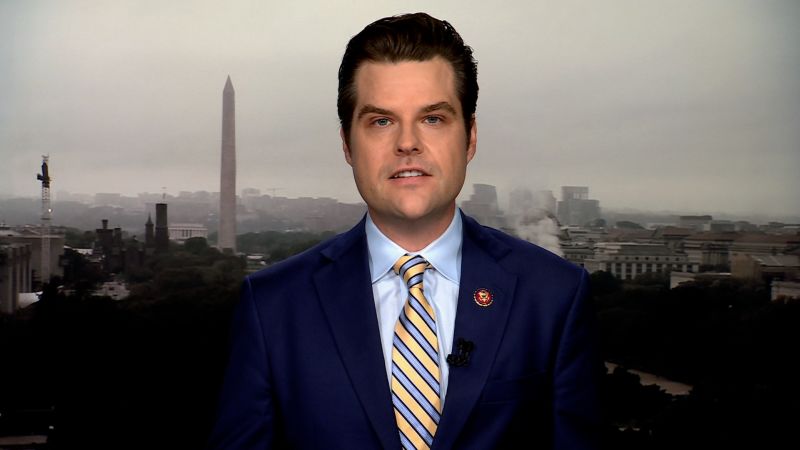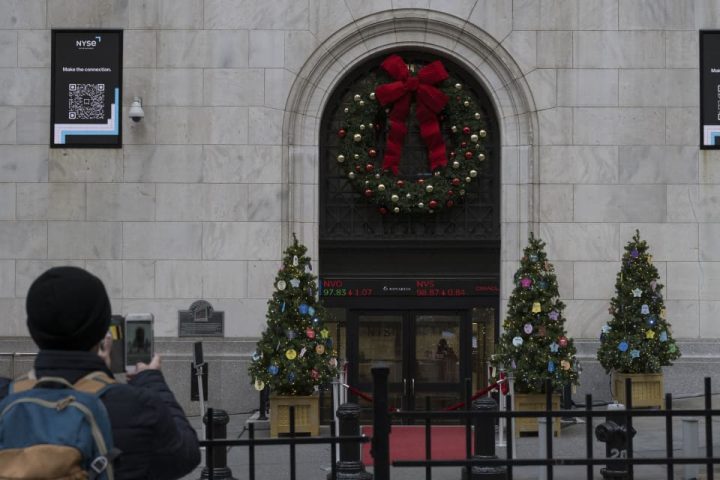Henrietta Treyz, director of economic policy research at Veda Partners, is no stranger to deciphering Washington, D.C., for investors. And there is a lot to decipher these days, what with two wars, a massive buildup of government debt, a congressional spending fight, and a continued struggle over who will replace ousted House of Representatives Speaker Kevin McCarthy (R., Calif.).
Treyz says she got a “Ph.D. in chaos” in her years on Capitol Hill as a Senate staff member during the 2008-09 global financial crisis. Since then, she has been helping investors understand the implications of politics and policy, most recently at Veda, where she is a managing director. Her advice: Know which lawmakers to watch, and understand what motivates them, to know how they will vote.
Barron’s spoke with Treyz in mid-September, days before Congress averted a government shutdown, and several times in the past week. An edited version of these conversations, which touched on government-shutdown odds, trade policy, and the 2024 presidential race, follows.
Barron’s: The world looks uglier than a few weeks ago and the U.S. Congress still looks dysfunctional, with the House leaderless after Rep. Steve Scalise quit the Speaker race. What does that do to the odds of a looming government shutdown?
Henrietta Treyz: The one-two political punch of the war in Israel and the need for a new Speaker is a boon to functionality, but it won’t be quick. I put 80% odds on some sort of a shutdown—20% on a full-scale shutdown in mid-November [when federal funding is slated to run out], 60% on a partial shutdown. And 20% odds that a short-term continuing resolution can be agreed to, averting a shutdown entirely.
What, then, can investors expect from Washington in the next month or so?
The Biden administration will focus more on trade and foreign policy. Following the review of the $360 billion in Section 301 tariffs imposed by President Donald Trump, which should take place by year end, some of the tariffs could come off, while others, including those imposed on industrial inputs such as wind turbines, could be raised.
The U.S.-European Union negotiations over [clean] steel and aluminum production are momentous. U.S.-European dialogue on trade has been strained for more than a century, largely over agriculture-related issues. But the Russian invasion of Ukraine has brought all these nations closer.
The U.S. and EU are working on a combined joint tariff system that effectively defines clean steel production in a way that the U.S. and EU are right under—and China above—a threshold of various metrics related to carbon emissions and export amounts. That would allow the U.S. and EU to apply tariffs to Chinese steel at the same time, and pressure China to produce clean steel and stop steel dumping.
How would an agreement between the U.S. and the EU help U.S. steel companies?
U.S. steel companies such as
Cleveland-Cliffs
[ticker: CLF] have been huge proponents of these tariffs against China. The more countries that impose tariffs akin to ours, the more benefit the U.S. steel companies could see.
The agreement could also eliminate the tariffs on steel and aluminum imposed under the Trump administration. Both the U.S. and EU suspended tariffs on each other as they worked on an agreement. The tariffs could be reimposed if there is no deal between the two by the end of October. If there is a deal, it would remove a cloud over the likes of
Levi Strauss
[LEVI] and
Harley-Davidson
[HOG], which were the focus of retaliatory tariffs.
What could be coming in terms of technology restrictions related to China?
Last October, the Biden administration rolled out a plan to blow a hole the size of the Grand Canyon [through China’s chip development] with export controls, letting China have legacy chips but curtailing its access to advanced technology from the U.S. China is three to five years behind us [in advanced chip development]. We want to stop them at that stage, while every year we grow more advanced. The U.S. is also bringing the EU and other allies, including Japan and the Netherlands, with us on this journey.
Revised regulations from the Commerce Department’s Bureau of Industry and Security, or BIS, are imminent on export controls in several major areas, including semiconductors, microelectronics, quantum information technologies, and artificial intelligence. The Biden administration doesn’t want to put the likes of
Nvidia
[NVDA] out of business, so it is allowing companies to apply for licenses to continue exporting as exceptions to the restrictions. But as time goes by, the circle of what is excluded [from export restrictions] is going to get smaller. Revenue from China will be substantially less for many U.S. tech firms.
You have said investors should keep an eye on the Commerce Department. Why?
BIS has always been powerful, but we are now in need of its tools that are perfectly designed to wage the current [geopolitical] battles. The actions we are seeing with export controls, and the new and inventive ways BIS tools have been used to sanction Russia, are more aggressive than ever before. BIS has grown substantially since the West started sanctioning Russia and as a function of the changing U.S.-China relationship and the administration’s “big fence, small yard” strategy [aimed at strengthening restrictions on China’s access to certain advanced technology].
Commerce just got a huge influx of cash via the Chips Act and the Inflation Reduction Act and is hiring 150 to 200 people. I expect future appropriations and spending bills will consistently provide more funding to Commerce, whether Democrats or Republicans are in office. Being anti-China is the most popular position in D.C., and many of the efforts to bolster our competitiveness with China are through this agency. My message to investors: Take it seriously. They are going fast.
Speaking of who’s in office, do you see a Biden-Trump race in 2024?
Yes, [barring] a health issue for Biden. In that case, someone else might try to enter the primary [running against Vice President Kamala Harris], but Rep. Jim Clyburn [D., S.C.] and the Congressional Black Caucus have supported Harris. Clyburn demonstrated in the 2020 election that he can single-handedly deliver support from the Black community.
I also don’t see anyone other than Trump getting the Republican nomination. He has 60% support in his party. [Former South Carolina Gov.] Nikki Haley, who is surging, has just 6%. The indictments have done nothing but boost his popularity with many Republican voters. You can tie his approval jump to the first indictment, and it has never relented.
How do you see the election playing out at this point?
A Biden presidency with a Republican Senate is my base case. National data show Biden and Trump neck and neck, but I looked at the swings away from Trump and to Democrats in the recent elections. For example, the Democrats were up by a 0.6-point margin in the governor’s race in Arizona, a state Trump won by 3.5 points in the 2016 election. A 4.1-point swing is huge.
The Georgia Senate race in 2022 showed an even bigger swing toward the Democrats. The main reason: abortion rights. The states to watch closely are Pennsylvania, Arizona, Nevada, Georgia, Michigan, and Wisconsin.
What are the likely market implications if Trump wins?
If Trump is elected, the House and Senate will likely both be Republican. In that case, you’re going to see another tax-cut bill, largely deficit-financed. The Trump campaign wants to extend all the individual tax cuts for a decade and reduce the corporate tax rate to 15%. Deficit increases would total $2 trillion to $3 trillion just to cover the tax cuts.
““A Biden administration and Republican Senate represents the best scenario for material deficit reduction.””
There would also be a risk of increased tariffs for lumber, furniture, baseball bats, anything manufactured in China, the European Union, Mexico, and Canada. The biggest negative affect would be felt by the big box retailers—the
Wayfair
s [W] of the world,
Lowe’s
[LOW],
Home Depot
[HD]. Trump has long looked to tariffs on foreign imports as the best way to raise revenue.
How would investors benefit from such tax cuts?
I don’t expect a stimulative [market impact] if the tax rate falls to 18% from 21%. Purely domestic restaurants, grocery stores, or regional banks that don’t have operations domiciled abroad, unlike
Apple
[AAPL] and
Microsoft
[MSFT], and can’t avoid the U.S. corporate tax rate, would be the biggest beneficiaries of a cut.
What would a Biden White House and Republican Senate mean for investors?
The administration would probably extend tax cuts for the majority of Americans and reinstate some of the business tax credits that expired, including for research and development. That would likely add $1 trillion to the deficit, lower than what would be added under a Trump presidency.
In 2010, when Biden was vice president, he and Sen. Mitch McConnell [R., Ky.], then Senate majority leader, negotiated a bipartisan deal to avoid a fiscal cliff and cut taxes.
A Biden administration and Republican Senate represents the best scenario for material deficit reduction. That would bring down bond yields and help Treasuries. This scenario would also be a boon to manufacturing because the clean-energy and electric-vehicle tax credits [from the Inflation Reduction Act] would be safe, as would the aid in the Chips Act.
Would that funding disappear in a second Trump administration?
That’s the widespread view, but I don’t expect Republicans to repeal the Inflation Reduction Act or Chips Act. They wouldn’t have the votes, and the IRA tax credits disproportionately go to Southern states, creating a lot of jobs and investment. Also, once you repeal this tax credit, it becomes a tax hike. Republicans aren’t tax hikers. Plus, repealing these measures just makes us more dependent on China [for chips and the green energy transition]. And no one wants that.
Thanks, Henrietta. B
Write to Reshma Kapadia at [email protected]
Read the full article here







